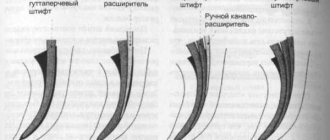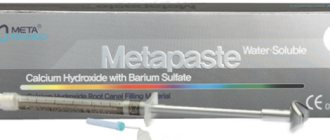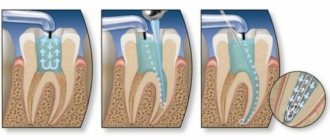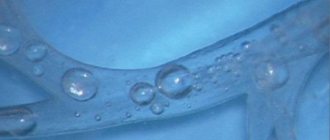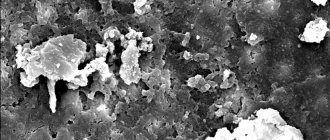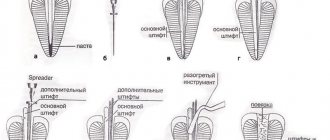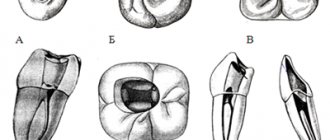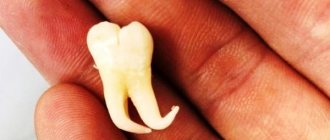The specific structure of the root canal determines the presence of a large number of branches, also known as microchannels. In situations where, as a result of filling, at least one of these cavities remains unclosed, there is a possibility of developing an inflammatory process, which, if prolonged, leads to tooth loss. The Thermafil system, which uses a soft gutta-percha composition, allows you to avoid such situations and achieve high-quality fillings.
General overview
The technology under consideration is one of the new methods of dental treatment, and guarantees the reliability of filling by placing heated gutta-percha in the cavity of the open canal, the basis for which is a plastic obturator. Three-dimensional obturation and complete sealing of the apex eliminate the likelihood of negative side processes that occur during the rehabilitation period. In addition, filling technology reduces the duration of the procedure and is recommended for use even with severe curvature of the canals.
Developed by Professor Johnson, the technology initially involved the use of medical steel rods coated with a layer of plastic material as a carrier. In modern Thermofil models, rigid polymer obturators of various diameters and tapers are used, on which marks are applied to facilitate control of the immersion of the equipment.
Heated gutta-percha has improved adhesive properties, ensuring tight fixation both at the base and in the cavity of the tubules. The presence of a plastic rod prevents shrinkage of the material. The method of using the system includes:
- Treatment of the obturator with a filling mass;
- Gradual introduction of the pin into the canal cavity;
- Natural filling of branches and volume as a result of the created pressure.
The technology of volumetric filling reduces the likelihood of infection of dental tissue, and allows you to reduce the amount of composite materials, which represent a potential source of negative impact on the jaw region. Practice shows that the painful sensations characteristic of the recovery period after medical intervention are expressed to a lesser extent.
It is worth noting that the protocol under consideration is associated with the clinic’s expenses for the purchase of special equipment, including a drill equipped with an endodontic attachment, an oven for softening gutta-percha, as well as sets of disposable instruments. As a result, the cost of treatment with the Thermafil system is higher than with alternative methods.
What it is?
The Thermafil system is a new method of dental treatment used for effective filling of tooth canals.
To do this, heated gutta-percha is used on a plastic carrier - an obturator. Today, this is the most effective canal filling system with three-dimensional obturation and complete sealing of the apex. This treatment method significantly reduces the specialist’s work time and guarantees high-quality filling. Even the narrowest, curved canals can be reliably filled with filling material.
Stages of filling
The algorithm for restoring the integral structure of the crown includes the following steps:
- Removal of pulp and expansion of the canal opening;
- Formation of a cone-shaped cavity and extraction of infected dentin;
- Determination of the working depth of the channel;
- Antiseptic treatment of all internal areas;
- Rinsing the cavity with a chlorhexidine solution;
- Drying and introducing sealer;
- Installation of a polymer rod and filling the lumen;
- Removing excess material;
- Polymerization of gutta-percha at the mouth of the canal;
- X-ray examination and repeated disinfection.
Implementation of the protocol requires special attention to a number of factors that can affect the quality of filling.
Correct determination of working depth
Because the technique involves filling the canal and all branches, it is important to ensure that the material used is sufficient to reach the bottom of the cavity. Otherwise, there is a high probability of developing complications, including inflammatory processes, pain, cyst formation or periodontitis.
Compliance with channel processing techniques
Mechanical expansion of the hole, elimination of existing defective areas and irregularities - all these are factors affecting the quality of filling the cavity with gutta-percha material. This is especially important when working with narrow and curved canals that require careful processing.
Filling root canals with Thermofil
The expression “nature abhors a vacuum” applies very appropriately to dentistry, namely to root canal treatment. There is probably not a person who is not familiar with such a dental procedure as removing a nerve from a tooth with subsequent filling of root canals. This is otherwise called endodontic treatment. Nerves have to be removed from teeth for many reasons, but most often due to complications of caries - pulpitis and periodontitis. After the nerve is removed from the tooth, an ignorant person may think that the treatment can be completed at this stage. The tooth doesn’t hurt, you can chew – what else do you need? But it's not that simple. An empty root canal, in fact, is an ideal “incubator” for the proliferation of pathogenic microbes. For the same reason, there are often relapses of inflammation in the peri-root tissues of teeth with incompletely or loosely sealed root canals. That is why in dentistry there are strict requirements for the quality of filling (obturation) of the root canals of teeth.
The generally accepted quality standard for root canal filling is dense and complete filling of the root canal. Density is ensured by the physical properties of the filling material, and completeness is ensured by the doctor’s qualifications. The fact is that the root canal must be sealed up to the apical hole, located at the tip of the root. Underfilling threatens with inflammatory complications (formation of cysts, granulomas), and overfilling (filling material extending beyond the root apex) can lead to pain after tooth treatment. The quality of filling the equine canals directly depends on the skill of the doctor.
Fig 1 Fig 2
Fig1. Cyst formation as a result of poor-quality root canal treatment
Figure 2. Fully sealed root canals
The main material for obturation (filling) of root canals is gutta-percha. Gutta-percha is a plant product obtained from the milky sap of tropical plants. In dentistry, specially processed gutta-percha is used, which gives it the required properties (density, radiopacity, flexibility, etc.). At the beginning of the 19th century, gutta-percha was recognized as the best material for filling root canals. From that moment on, scientists began to develop methods for using gutta-percha in dentistry.
Over time, dental materials and technologies have improved, which ultimately led to the emergence of such a root canal filling system as Temafil (Thermafil). Thermophil is a system for filling the root canals of teeth with heated (softened) gutta-percha.
Thermofil system for filling root canals consists of filling pins and a special heating device for softening the gutta-percha of the filling pin.
Fig 3 Fig 4
Fig 3. Thermafil obturators
Fig. 4. Device (oven) for heating obturators
A filling pin (obturator) is a cone-shaped rod (can be plastic or metal) coated with a thin layer of gutta-percha.
The method of filling root canals with the Thermafil system consists of several stages. First, the nerve (pulp – neurovascular bundle) is removed from the root canal using special instruments. The root canal is then widened and given a conical shape. During the expansion process, a layer of infected dentin (the inner tissue of the tooth) is removed from the walls of the root canal. To determine the length of the root canal, a special device is used - an apex locator. It allows you to very accurately determine the working length of the root canal, which is necessary for its full treatment and filling.
Fig 5 Fig 6
Fig 5. Apex locator
Fig 6. Instruments for mechanical treatment of root canals
An indispensable condition for complete root canal treatment is its high-quality antiseptic treatment. To do this, the canal is washed repeatedly during the treatment with a solution of a strong antiseptic (sodium hypochlorite, chlorhexidine).
When the root canal is mechanically and antiseptically treated, it is dried with paper points, which are inserted into the lumen of the canal.
Now you can proceed directly to filling the canal. Filling the root canals completes the treatment of pulpitis and the treatment of periodontitis. A special limiter on the Thermofil pin sets the length to which the obturator must be inserted to completely fill the root canal. Then the obturator is heated with a device to soften the gutta-percha. Before filling, a thin layer of sealant is applied to the walls of the root canal - a special paste that ensures the filling of all micro-branches of the canal. The heated obturator is smoothly inserted into the root canal up to the limiter. After which the obturator is cut to the mouth of the root canal and an X-ray image of the filled tooth is taken. After making sure that the root canal is fully filled, you can begin restoring the tooth, which is done at your next visit to the dentist.
Fig 7 Fig 8
Figure 7. Root canal filling with Thermafil obturator
Fig. 8. The obturator is cut to the level of the entrance to the root canal (canal mouth)
Advantages of the Thermophile method
The root canals of teeth have a complex anatomical structure. In most cases, the main root canal has many side branches - microchannels. As a rule, these branches are present in the apical third of the root canal - the area most critical to the quality of the filling. Unsealed branches of the main canal are potential sources of infection, leading to inflammatory complications and, as a result, tooth loss.
Fig 9 Fig 10
Fig. 9. An extensive network of branches of the root canal
Fig. 10. Complete obturation of the main canal and its branches with Thermafil
Conventional root canal filling methods do not always achieve the desired result, and voids present in the root canal after poor-quality filling often lead to complications.
The technique of filling canals with Thermofil does not have these disadvantages. Softened gutta-percha, introduced under pressure into the canal on a carrier (rod), completely fills the entire volume of the root canal, including its branches. When filling, the doctor clearly controls the depth of insertion of the rod, which allows the canal to be accurately filled to the apical foramen. The plasticity of the carrier (rod) makes it possible to fill even highly curved root canals. If it is necessary to re-treat or prepare the root canal for a pin structure (restoration of a tooth on a pin, restoration with a core inlay), Thermafil can be easily removed from the root canal.
X-ray pictures. Complete filling of root canals with Thermafil
The conducted studies have proven excellent sealing of the root canal after filling with Thermofil. It is 20 times higher than when filling the root canal with a conventional gutta-percha pin and four times higher than the same indicator when filling the root canal by introducing gutta-percha using a syringe.
Advantages and disadvantages
Positive aspects noted when using the Thermophile system include:
- Guaranteed sealing of the canal cavity;
- Minimal risk of inflammation after filling;
- Low level of toxicity of materials;
- Preservation of an integral apical structure;
- Control over the depth of penetration of the rod;
- Free access for re-treatment;
- No pain during the rehabilitation period.
The only technical drawback characteristic of all composite materials is the likelihood of minimal shrinkage of the formed filling.
When is the method most effective?
The use of the system is most effective in the following cases:
- for infectious lesions of the dental root system;
- when removal of the inflamed pulp is required;
- in case of severe curvature of channel branches and the channel itself;
- with the initial destruction of the root canal;
- to shape the cavity before filling;
- direct installation of the filling.
The most difficult case is the need to treat a previously filled tooth, if the filling of the holes was carried out poorly. In this case, three-dimensional filling is also at its best.
Many clinical studies have been conducted that have proven the effectiveness of the Thermofil system. With its help, it is possible to reliably seal the canal cavity while maintaining the result for many years to come.
What is the advantage of thermophile?
This procedure was invented several years ago through the joint development of scientists to find optimal methods for completely and effectively filling deep dental canals. Traditionally, the best substance used for this operation is gutta-percha, a natural material that is extracted from the sap of tropical plants. Possessing such qualities as plasticity, flexibility and radiopacity, gutta-percha has been used for over two centuries to effectively fill the internal canals of teeth.
However, for many years, dentists have been faced with the main problem in this regard - the impossibility of fully filling the canals due to their particular complexity, difficulty in determining the length, and analyzing the lateral canaliculi. Only the thermophilic filling system, which is based on the ability to soften gutta-percha to the required level using a special device and qualitatively fill the entire canal with it, has made it possible to make a significant step forward in this regard.
Benefits of filling teeth with gutta-percha:
- High speed operation about 30-40 minutes
- High-quality root canal sealing
- Possibility to fill the entire volume of the root canal with paste
- Reliable antiseptic treatment
- Eliminating the risk of inflammatory processes
- Careful doctor supervision at all stages of canal filling
In conclusion, it should be said that today filling with gutta-percha is considered the most reliable and safe, in which you can fill a tooth with high quality and not be afraid of the development and treatment of caries, the penetration of infections, or the risk of losing a tooth. Leading European and Russian dental clinics successfully perform all types of gutta-percha fillings.
